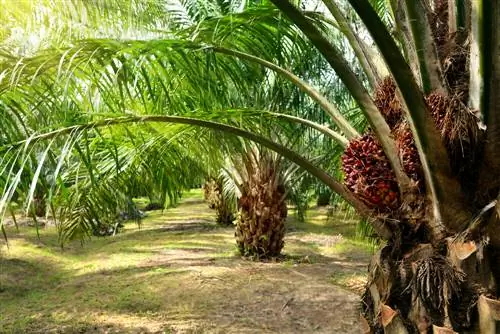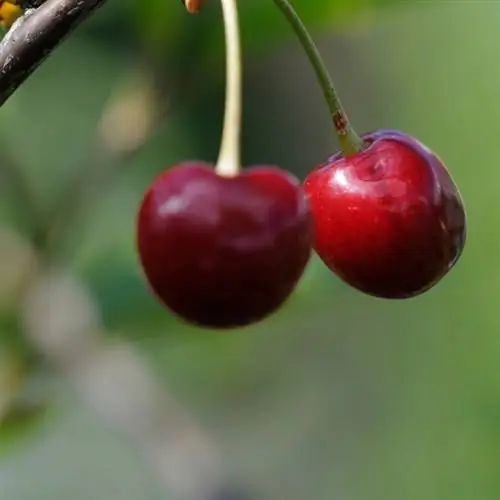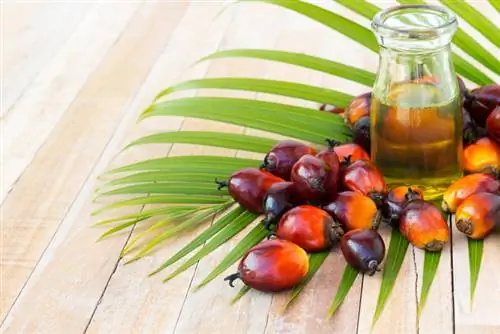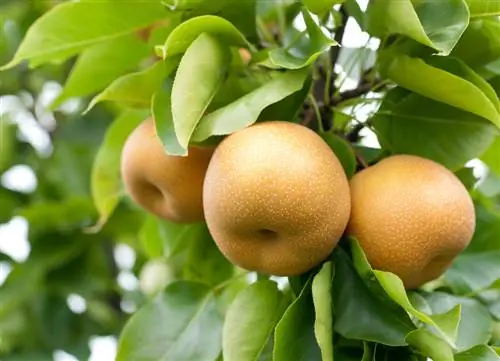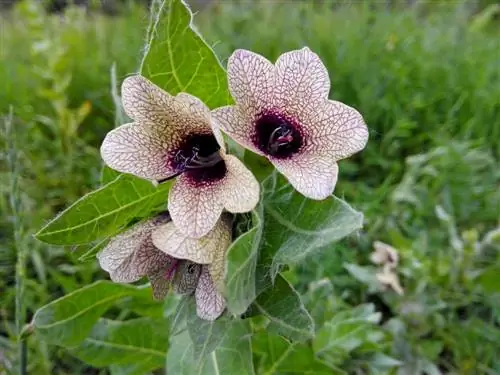- Author admin [email protected].
- Public 2023-12-16 16:46.
- Last modified 2025-01-23 11:22.
Read the commented oil palm profile here for information on growth, fruit and the use of palm oil. You can find out how to properly plant and care for Elaeis guineensis here.
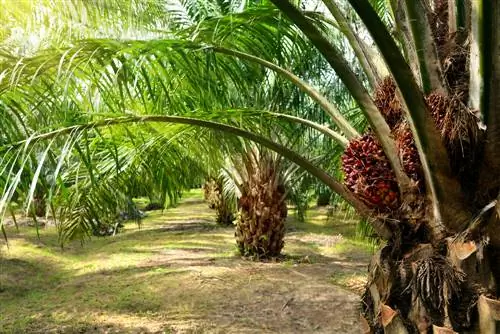
What is the oil palm and what is it used for?
The oil palm (Elaeis guineensis) is an important plant for palm oil production and originally comes from West Africa. The palm tree grows up to 30 m high, has pinnate leaves and bears orange drupes. Palm oil is used in food, cosmetic products and as biofuel.
Profile
- Scientific name: Elaeis guineensis
- Family: Palm family (Arecaceae)
- Origin: West Africa
- Growth type: palm tree
- Growth habit: single-stemmed
- Growth height: 20 m to 30 m
- Flowers: Spikes
- Fruits: Drupes
- Leaves: pinnate
- Roots: soil and aerial roots
- Winter hardiness: sensitive to frost
- Use: Crop, palm oil production, indoor palm
Growth
The oil palm (Elaeis guineensis) is one of the economically most important palm species for palm oil production. Originally native to the rainforests of West Africa, the palm oil plant is now cultivated on huge plantations in Southeast Asia and South America. Key growth data worth knowing is almost the following overview:
- Growth form: single-stemmed palm tree with a dense crown of feathery fronds, large flower spikes and high-yielding fruit clusters.
- Growth height: 20 m to 30 m.
- Trunk: 25 cm to 75 cm diameter.
- Special feature: from the age of 15, the leaf stumps fall off and develop into the typical, rough-structured palm trunk.
- Growth speed: 20 cm to 60 cm height growth annually.
- Roots: meter-deep taproots, strongly branched lateral roots up to 60 cm soil depth, aerial roots up to 100 cm trunk height.
- Properties interesting for hobby gardeners: decorative, heat-requiring, durable, easy to care for.
Flowers
Elaeis guineensis thrives as a monoecious, separate-sex palm. Flowers of both sexes can be found on an oil palm as inflorescences worth seeing with these characteristics:
- Inflorescence: 5-10 cm thick inflorescence axis, branched with up to 200 spikes and 150,000 to 200,000 flowers.
- Single spike: 700 to 2,000 flowers.
- Pollination: Weevils, primarily species of the genus Elaeidobius.
Female and male inflorescences are easy to distinguish for the untrained eye by their position: A female inflorescence is located in the axil of a thorny bract. A male inflorescence sits in a leaf axil without thorns.
Fruits
Within 5.5 to 9 months after pollination, huge fruit clusters with these characteristics ripen on an oil palm:
- Fruit stand: branched fruit group with 800 to 4,000 orange-red individual fruits.
- Oil palm fruit: 3-6 cm long, 2-4 cm wide, weighing 20 g.
- Pump: fibrous, yellowish-reddish, oil content of 45% to 50%.
- Fruit consistency: hard when unripe, later soft.
- Kern: Stone bowl with 1 to 2 seeds.
- Seeds: 48% to 52% oil content.
A fully grown oil palm produces an average of 18 fruit heads annually as a raw material for palm oil production. This results in a high yield of 4 to 6 tons of palm oil per hectare and year.
leaves
North of the Alps, the leaves are the most beautiful decoration of an oil palm. Far from the rainforests, the palm oil plant only flowers and produces fruit under the tropical growing conditions of botanical gardens. These attributes characterize an oil palm leaf:
- Leaf shape: petiolate, pinnate, regularly divided.
- Leaf size: up to 7 m long (cultivated as a container plant up to 2 m long).
- Leaf color: evergreen, dark green
- Special feature: Petiole with fibrous spines on the edge.
Under ideal conditions, up to 35 new feather fronds sprout per year. Individual leaves remain in the palm's vegetation cone for 2 to 3 years before they wither, dry out and break off. Only the leaf stumps remain on the trunk.
Usage
Palm oil is heat-resistant, long-lasting, odorless and cheap. Due to these properties, palm oil is the ideal raw material for cosmetic products, the food industry and biofuel. For this reason, palm oil is the most widely grown vegetable oil in the world, ahead of soybean oil. The following table provides an insight into the global use of palm oil and palm kernel oil:
| Food | Non-food products |
|---|---|
| Margarine | Cosmetic products |
| Salad oil | Detergent |
| Confectionery | Cleaning supplies |
| Baked goods | Body lotion, skin cream |
| Baby food | Hair shampoo |
| Whipped cream | Mascara |
| Chocolate, pralines | lipstick |
| Ready meals, pizza | Soap |
| Contact soups | Candles |
| Roasted Peanuts | Biodiesel |
The production of palm oil is viewed critically. In order to make room for ever larger oil palm plantations, rainforests are being destroyed with fatal consequences for nature, the environment and biodiversity. What is worrying is the use of toxic herbicides on palm oil plantations, which leads to serious poisoning of workers and small farmers every year. Palm oil is now contained in every second product, which means there is no alternative to phasing out palm oil production. Switching to other oil crops, for example for the production of coconut oil, would increase land consumption many times over. So is palm oil better than its reputation? The following video is dedicated to this question:
Video: Is palm oil unfairly demonized? - Dirk Steffens is looking for an answer
Planting oil palm
It is rare to buy an oil palm that is ready to plant. It is more promising to purchase seeds from specialist exotic seed shops. The hand-picked seeds are sold individually for a price starting at 4.95 euros. How and where you can successfully plant your personal palm oil plant can be found here:
Sowing
A warm water bath stimulates the germination of oil palm seeds. Warm, humid conditions simulate a tropical rainforest climate so that the valuable seedling roots and grows quickly. This is how sowing works:
- Put seeds in lukewarm water for 48 hours.
- Fill the deep growing pot with a mix of seed soil and coconut fiber in equal parts with a little sand.
- Put soaked seeds into the substrate.
- Water the substrate with room temperature, soft water.
- Place the pot in a heated indoor greenhouse in a partially shaded to shady location.
- Germination temperature: 25° to 30° Celsius.
- Keep constantly slightly moist, ventilate daily.
- Caution: drying out once can destroy the seeds.
Within about four weeks, the radicle and the unpinnate cotyledon break through the seed coat. A radicle grows up to 20 cm long and forms a ring of extremely thin adventitious roots at the base. Once the first primary root develops, the radicle dies. The seedling stage lasts two to three months and ends with the growth of the sixth leaf.
Planting oil palm
At the end of the seedling stage, a young oil palm is ready to be planted in a container. High-quality palm soil without peat, enriched with coconut soil as a peat substitute and lava granules, is suitable as a substrate. How to plant an oil palm correctly:
- Create a 10 cm high drainage made of pottery shards in the palm pot.
- Fill in the substrate up to half the height of the pot.
- Form a depression in the substrate the same diameter as the root ball.
- Unpot the young palm tree, place it in the hollow, fill up the remaining substrate except for a watering edge.
- Press palm soil and water thoroughly.
Extra tip: By filling the coaster with expanded clay balls (€11.00 on Amazon), excess irrigation water can accumulate and evaporate without the risk of waterlogging for an extra percent of humidity.
Location
These are the ideal growing conditions for an oil palm as a container plant:
- Partially shaded to shady location.
- All year round at normal room temperature.
- Temperature minimum: 18° Celsius.
- High humidity from 60% to 80%.
Suitable locations are all humid rooms, such as a greenhouse, bathroom or indoor swimming pool. In combination with a humidifier, the oil palm feels comfortable in a temperature-controlled winter garden or on a heated, glazed terrace.
Excursus
Palm oil in tank destroys rainforests
Did you know that a large part of the world's palm oil production ends up in car tanks? In fact, organic diesel always contains palm oil. In 2017, 51 percent of palm oil imports to Germany were used to produce biofuels - and the trend is rising. As a result, it is not the food industry that is the main consumer of palm oil in this country, but transport. To put it simply: With every tank of bio-diesel, a small piece of the rainforest dies.
Care for oil palm
In the right location, an oil palm is easy to care for. A regular supply of water and nutrients is important. Occasional trimming care ensures a well-groomed appearance. The best care tips in a nutshell:
Pouring
- Keep the substrate slightly moist without waterlogging.
- Use room temperature, stale tap water or collected rainwater as irrigation water.
- Extra tip: Spray palm fronds once a week.
Fertilize
- Fertilize oil palm from March to October.
- Add liquid palm fertilizer to the irrigation water every month.
Cutting
- Cut oil palm like a classic indoor palm.
- Cut off completely dried palm fronds.
- When cutting, leave a leaf stump on the trunk.
- Suitable tool: bypass scissors or Japanese saw, freshly sharpened and disinfected.
Wintering
- Do not fertilize palm oil plants from November to February.
- Water more sparingly, spray regularly.
- Protect from cold drafts by tilting windows.
Repotting
- Repot oil palm every one to two years.
- The best time is in spring.
- Unpot the palm tree, shake off the old substrate, cut off the dead roots.
- Correct pot size: two fingers fit between the root ball and the edge of the container.
Popular varieties
The pure olive tree species Elaeis guineensis is divided into these varieties according to the fruit colors:
- Elaeis rubro-nigrescens: deep orange oil palm fruit, orange pulp, reddish palm oil.
- Elaeis rutilo-nigrescens: pale orange fruit peel, black in the upper half.
- Elaeis virescens: reddish-orange fruits with green tips.
- Elaeis albescens: Rarity with ivory-colored drupes with black or green tips.
FAQ
How is palm oil produced?
Palm oil is obtained from the pulp of the stone fruits of an oil palm tree. The palm fruits perish quickly and are processed promptly after harvest. The fruit heads are sterilized with steam, pressed and the seeds are removed. Due to its high carotene content, raw palm oil is still orange-brown to reddish in color. After refining, palm oil is light, clear in color, smells of violets and has a sweet taste.
What is palm kernel oil?
Palm kernel oil is made from the seeds of oil palm fruits. As part of production, the seeds are dried, ground and pressed. Palm kernel oil is mainly used for the production of surfactants. These detergent-active substances are contained in all commercially available detergents and cleaning agents in a proportion of up to 30 percent. Together with coconut oil, palm kernel oil is one of the lauric oils that are of great importance in olechemistry.
Is an oil palm fruit edible?
The fruit of an oil palm is edible and very similar to an olive. A hard stone core is surrounded by fleshy, creamy pulp that is laced with fibers. Oil palm fruits are characterized by a high oil content and a sweet taste. Because the stone fruits spoil quickly, they are processed into palm oil and palm kernel oil immediately after harvesting.
What are the optimal growing conditions for an oil palm?
As a tropical plant, the oil palm (Elaeis guineensis) depends on a warm, humid rainforest climate. Important criteria for productive cultivation are average temperatures of 28° Celsius and nutrient-rich, moist and deep soil without waterlogging. The most common maintenance work in oil palm plantations is regular fertilization and weeding. At least once a year, plantation workers cut off dead, unproductive palm fronds.

